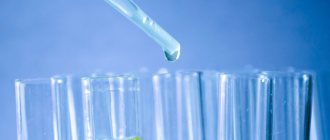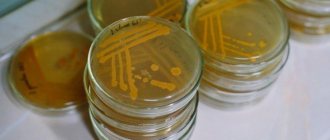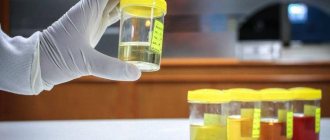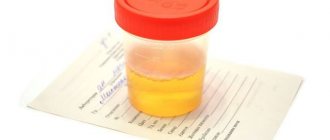Preparation
Special preparation for urine collection for urine analysis according to Zimnitsky is not required.
You must first agree with your doctor about stopping diuretics (diuretics) on the day of urine collection.
The patient should record the amount of all fluids consumed on the day of urine collection (water, tea, coffee, juices, soups, and intravenous drips) and provide this data to their doctor along with the test results.
You must first obtain 8 sterile containers from the laboratory or purchase them at the pharmacy. Also at the pharmacy you need to purchase a container for collecting urine with graduation to determine the volume of each portion of urine.
Urine collection procedure:
Urine is collected throughout the day.
At 6 o'clock in the morning, empty your bladder, pour this portion of urine into the toilet, its volume is not recorded.
Over the next 24 hours, 8 portions of urine are collected every 3 hours (until 6 o'clock the next morning).
- 1st portion - from 06:00 to 09:00
- 2nd portion - from 09:00 to 12:00
- 3rd portion - from 12:00 to 15:00
- 4th serving - from 15:00 to 18:00
- 5th portion - from 18:00 to 21:00
- 6th portion - from 21:00 to 24:00
- 7th portion - from 24:00 to 03:00
- 8th portion - from 03:00 to 06:00
Urine collection is carried out in a dry, clean, graduated container.
After each urination, it is necessary to record the volume of the collected portion (for example, 256 ml).
Then the urine in the container needs to be mixed and some (about 60 ml) poured into one sterile container, the remaining urine should be poured out.
On the container write the volume of the entire portion and the time of collection of this portion.
Close the container tightly with a lid and store in the refrigerator at a temperature of +2...+8°C.
Thus, you need to collect 8 portions of urine per day.
The next morning, deliver all portions to the laboratory.
IMPORTANT! If you did not urinate during a certain period of urine collection (for example, from 15.00 to 18.00 hours), then an empty container must be delivered to the laboratory. On the empty container, indicate the time interval and serving volume - “0 ml”.
There is no need to get up specifically at night to urinate if there is no urge to urinate.
Collection of urine for research according to Zimnitsky
Purpose : determination of the concentration and excretory functions of the kidneys.
Indications: Doctor's prescription. There are no contraindications.
PATIENT PREPARATION:
1. Explain to the patient that drinking, eating and movement regimens should remain the same.
2. Urine must be collected 24 hours in advance, every 3 hours.
3. The doctor stops diuretics the day before the test.
SEQUENCE OF PATIENT ACTIONS:
(or nurses if the patient is on bed rest)
1. Give the patient 8 numbered containers with time stamps and a 9th spare. At 6 o'clock in the morning the patient urinates in the toilet.
2. Then, for every 3 hours, the patient urinates in an appropriate container until 6 am the next day, the morning portion is included in the study.
3. The resulting containers must be tightly closed with lids with labels attached that read:
- FULL NAME. patient;
— department number;
— room number;
— time interval (6-9; 9-12; 12-15; 15-18; 18-21; 21-24; 24-3; 3-6).
4. Ensure delivery of urine to the laboratory.
5. Treat the used gloves, funnel, diuresis, vessel (urinal) in a disinfectant solution, then soak in it - for at least 60 minutes, separately.
ADDITIONAL INFORMATION.
The nurse should remember that she must wake the patient every three hours at night.
Urine. collected at 6 a.m. the day before is not examined, since it is isolated due to the previous day.
If the patient has polyuria and does not have enough volume in one container, the nurse gives him an additional container, which indicates the appropriate period of time. If the patient does not have urine at any time, this container should remain empty.
EVALUATION OF RESEARCH RESULTS
The nurse should know that daily portions are collected from 6.00 to 18.00 hours.
Daily diuresis is 2/3-4/5 daily.
Normal urine density is 1010-1025. Normal daily diuresis is 1.5-2 liters and depends on many factors.
When assessing the results, the nurse should determine:
- daily diuresis;
— the sum of all sample volumes;
— separately the first 4 (day) and last 4 (night) volumes;
- the ratio between night and daytime diuresis;
- using a urometer, the density of urine in each portion.
- Pouring urine from the container into a measuring cylinder and lowering the urometer into it so that it reaches the bottom, and then determine at what division the level of urine is along the LOWER MENISCU.
— Write down the result in the direction.
Normally, daytime urine portions have a lower relative density than nighttime ones, but not lower than 1010.
A REDUCTION IN URINE DENSITY BELOW 1010 INDICATES A DECREASE IN RENAL CONCENTRATION FUNCTION.
If the density of urine is not enough to determine, then its density is determined as follows: the resulting sample is diluted 2 times with water, measured with a urometer and the result obtained is multiplied by 2.
If the volume of urine is very small, you can dilute it 3 times or more, and, accordingly, multiply the result by this value. Write down the received data in the form in the appropriate column.
Interpretation of the result
At the medical office, you can get personal advice from a doctor from the “Doctor Q” service on interpreting the results of the study during your appointment or by phone.
It must be remembered that interpretation of the results of a urine test according to Zimnitsky should only be carried out by a doctor, since the results of laboratory tests are not the only criterion for making a diagnosis and prescribing appropriate treatment. They should be considered in conjunction with medical history and the results of other possible examinations, including instrumental diagnostic methods.
An adult normally excretes approximately 67–75% of the liquid he drinks during the day. Daytime diuresis should exceed nighttime and amount to 2/3–3/4 of the total amount of daily urine. The relative density during the day ranges from 1.005 to 1.025 g/ml.
If night diuresis predominates over daytime diuresis, then this indicates a decrease in the concentrating ability of the kidneys. Nocturnal predominance of diuresis is often found in diabetes insipidus and heart failure.
An excess of urine density above 1.025 g/ml is observed in cases of dehydration, pyelonephritis, and uric acid diathesis in children.
A decrease in urine density below 1.005 g/ml indicates a decrease in the concentration function of the kidneys and occurs in renal failure, chronic glomerulonephritis and pyelonephritis, diabetes insipidus and diabetes mellitus, hyperaldosteronism, while taking diuretics, severe potassium deficiency, excess calcium,
To confirm the resulting pathological abnormalities, the doctor may prescribe stress tests to the patient to dilute and concentrate urine.
Reminder for collecting urine tests
Technique for collecting urine for general analysis
After toileting the external genitalia, morning urine is collected for general analysis in a disposable pharmaceutical container of at least 50 ml.
The urine container must be delivered to the laboratory between 7:30 and 10 am.
Technique for collecting urine analysis “according to Nechiporenko”
After toileting the external genitalia, collect an AVERAGE portion of morning urine with a volume of at least 20 ml. The first and last portions of urine are poured into the toilet into a disposable pharmaceutical container.
The urine container must be delivered to the laboratory between 7:30 and 10 am.
Technique for collecting daily urine
Urine is collected over 24 hours. In the morning before urine collection
toilet the external genitalia. The first portion of urine in the morning is released into the toilet and the time of urination is noted. Next, all urine during the day (until the same time the next day) should be collected in one container (usually a 3-liter jar with a lid is used, which is stored in the refrigerator).
After collecting the material, you must independently assess the total volume of urine collected. After which the urine is mixed and part of it (at least 100 ml) is poured into a special container. It is this container that is delivered to the laboratory (the entire volume of urine does not need to be delivered) from 7-30 to 10 am.
When submitting urine to the laboratory, it is necessary to indicate from what time to what time the urine was collected; what is the total volume of urine?
It is allowed to collect urine up to 12 hours in advance.
Technique for collecting urine for bacteriological culture
Prepare a sterile container for collecting urine. Wash your hands with soap, then thoroughly wash your external genitalia.
- after washing, take a sterile container to collect urine, open the lid so as not to touch the inner surface of the lid and container;
- release the first stream of urine into the toilet, hold urination, place a container, release urine into the container in an amount of at least 10 - 15 ml, flush the remaining portion of urine into the toilet. Carefully close the lid of the container without touching the edges of the neck.
Hypothermia, overheating and spilling urine are not allowed!
Analysis is accepted strictly from 7:30 to 8:45 (except weekends)
Technique for collecting urine for glucosuric profile
Daily urine is collected in three clean separate jars, and the time of urine collection is signed on each jar.
- from 6-00 to 14-00.
- from 14-00 to 22-00.
- from 22-00 to 6-00.
The amount of urine collected is measured in ml.
The amount of urine collected is measured. The amount is indicated in ml.
Urine is poured from each jar into a separate plastic container (at least 50 ml), and the time of urine collection is signed on each container.
Containers with urine must be delivered to the laboratory between 7:30 and 10 a.m. (except weekends).
Urine collection technique for the Rehberg test
The Rehberg test involves collecting urine and blood samples. The day before, exclude physical activity, alcoholic drinks, strong tea, spicy and fatty foods.
Urine is collected over 24 hours. In the morning, before collecting urine, toilet the external genitalia. The first portion of urine in the morning is released into the toilet and the time of urination is noted. Next, all urine during the day (until the same time the next day) should be collected in one container (usually a 3-liter jar with a lid is used, which is stored in the refrigerator).
After collecting the material, you must independently assess the total volume of urine collected. After which the urine is mixed and part of it (at least 150 ml) is poured into a special container. It is this container that is delivered to the laboratory (the entire volume of urine does not need to be delivered) from 7-30 to 10 am.
When submitting urine to the laboratory, it is necessary to indicate from what time to what time the urine was collected and the total volume of urine. Indicate your height, weight and amount of liquid drunk during the day.
When delivering a urine test to the laboratory, it is necessary to donate blood on that day to determine the level of creatinine (fasting)
Urine collection technique according to Zimnitsky
During the study, daily, daytime and nighttime diuresis and the relative density of urine in each of the 3-hour portions are determined.
Urine collection for the Zimnitsky test is carried out at certain hours during the day. The test is carried out with normal drinking and nutrition.
In order to correctly collect the required material you need:
- 8 clean containers with a lid, each holding a volume of 200 ml - these can be obtained from the hospital laboratory (label the time of urine collection on each)
- A watch, preferably with an alarm (urine collection should occur at certain hours)
- A notepad for recording the liquid consumed during the day (including the volume of liquid received with soup, milk, etc.)
How to collect urine for research according to Zimnitsky?
At 6 o'clock in the morning you need to empty your bladder into the toilet. Throughout the day, every 3 hours you need to empty your bladder into jars (if one container is not enough, take an additional container)
Strictly observe a 3-hour gap between urine portions!
- from 6 to 9 am - collect all urine excreted over the next 3 hours into the first container;
- from 09 to 12 o'clock - to the second container;
- from 12 to 15 o'clock - on the third;
- from 15 to 18 hours - on the fourth;
- 18 to 21 o'clock - at five;
- from 21 to 24 o'clock - at six;
- from 24 to 03 o’clock – at seven o’clock;
- from 03 to 06 a.m. fill the last, eighth container.
Jars to be filled must be kept cool and closed (in the refrigerator). The next morning, you must take all the jars with their contents to the laboratory, additionally providing records of the liquid consumed during the day.
Preparation, collection and transportation of urine for bacteriological examination
It is advisable to collect biomaterial before using antibacterial, antifungal or immunobiological therapy. If treatment is prescribed, it is recommended to complete the course and then conduct an analysis after 10-14 days.
- Urine is collected STRICTLY in sterile containers, observing hygiene rules
- After thoroughly toileting the external genitalia, without touching the body with the sterile container, collect a medium portion of morning urine (release a little urine, stop urinating and then collect 3-5 ml in the container).
- A lidded container with biomaterial is delivered to the laboratory. If rapid transportation is not possible, it is permissible to store the biomaterial at a temperature (+4...+8°C) for no more than 24 hours.
Preparation for urine analysis according to Nechiporenko
The purpose of the study is to objectively assess the condition of the kidneys.
During the analysis, leukocytes, red blood cells and casts are determined.
An average portion of urine is taken for testing.
Preparation for the procedure is simple:
- Avoid spicy and salty foods, as well as foods that affect the color of urine, on the eve of the test.
- Stop taking diuretics two days before the test.
Collection technique:
- Carry out hygiene of the external genitalia.
- It is necessary to collect an average portion of urine, i.e. release the first part of urine into the toilet, then stop urinating and collect the middle portion in a container.
- A lidded container with biomaterial is delivered to the laboratory.
Urinalysis according to Nechiporenko does not require 100% sterility of the collection container, since it does not involve counting and identifying bacteria.
How to prepare for urine collection according to Zimnitsky?
This study does not require any special preliminary preparation; you also do not need to follow a diet or any special drinking regime. The test should show how your kidneys work under normal conditions. It is only recommended to refrain from eating very salty and spicy foods that provoke severe thirst. You shouldn’t artificially overload your body by drinking a lot of water just like that.
The main preparatory measures are to purchase sterile medical containers for collecting and transporting urine. Their standard capacity is 200-250 ml, the minimum quantity is 8 pieces, but it is better to take 2-3 spare ones. If you do not have the opportunity to acquire such containers, it is quite possible to use glass jars of a similar volume (like those in which mayonnaise is sold) to collect urine for analysis according to Zimnitsky. The containers must be sterilized over steam for 2-3 minutes, and the lids must be boiled.
Labels indicating the time intervals should be affixed to prepared containers or jars:
- 09:00-12:00
- 12:00-15:00
- 15:00-18:00
- 18:00-21:00
- 21:00-00:00
- 00:00-03:00
- 03:00-06:00
- 06:00-09:00
Preparing for a general urine test
No special preparation is required for the study. The material should be collected in the morning, while the urine that has accumulated there overnight is still in the bladder. Before urinating, general hygiene procedures are required. The container for urine must be sterile, for which you can purchase disposable cups at the pharmacy. To reduce the risk of microbes from the genitals getting into the sample, it is recommended to first release a little urine, and then, without stopping, substitute the container. In total, you need to collect approximately 50 milliliters of material or a little more. The sample can be stored for no more than 2 hours in the refrigerator, otherwise the information content of the analysis is significantly reduced.
The norm in the table and interpretation of the results
The results of a urine test according to Zimnitsky will be ready in 1-3 business days - this depends on the internal regulations of a particular laboratory. There is very little data in the final form, let's look at each indicator and find out what deviations from normal values may indicate.
Important: diuresis of children over 10 years of age approaches the values characteristic of an adult. You can calculate the norm for a younger child using the formula: 600 + 100 x (n – 1), where n is the age in years. For example, the diuresis of a three-year-old baby will be approximately 800 ml.
Urine analysis standard according to Zimnitsky:
| Daily diuresis | 1500-2000 ml |
| Ratio of urine output to fluid intake | 65%-80% |
| Ratio of nighttime to daytime diuresis | 1/3 |
| Rate of urine production | high |
| Fluctuation in urine density | 1,003-1,035 g/l |
| Density of urine in one container | >1020 g/l |
| Average urine density | <1035 g/l |









